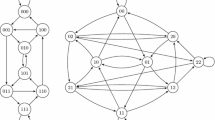Abstract
An order n binary de Bruijn sequence is a periodic sequence of bits with period \(2^n\) in which each n-tuple of bits occurs exactly once. We consider the longest subsequences shared by two de Bruijn sequences. First, we fix one de Bruijn sequence and prove that de Bruijn sequences sharing a longest subsequence with it must be those obtained by a single cross-join operation from it. Then determining such sequences is equivalent to finding cross-join pairs with maximum diameter. Second, we prove that for \(n\ge 5\), there exist two de Bruijn sequences of order n sharing a subsequence of length \(2^n-2\), i.e., there exists sequence \(a_0a_1\cdots a_{2^n-3}\) with length \(2^n-2\) such that both \(a_0a_1\cdots a_{2^n-3}01\) and \(a_0a_1\cdots a_{2^n-3}10\) are periods of de Bruijn sequences.
Similar content being viewed by others
References
Çalik Ç., Turan M.S., Özbudak F.: On feedback functions of maximum length nonlinear feedback shift registers. IEICE Trans. Fundam. Electron. Commun. Comput. E93–A(6), 1226–1231 (2010).
Chan A.H., Games R.A., Key E.L.: On the complexities of de Bruijn sequences. J. Comb. Theory A 33(3), 233–246 (1982).
Chang Z., Ezerman M.F., Ling S., Wang H.: Construction of de Bruijn sequences from product of two irreducible polynomials. Cryptogr. Commun. 10(2), 251–275 (2018).
Coppersmith D., Rhoades R.C., VanderKam J.M.: Counting De Bruijn sequences as perturbations of linear recursions. arXiv e-prints. arXiv:1705.07835 (2017)
de Bruijn N.G.: A combinatorial problem. Koninklijke Nederlandse Akademie van Wetenschappen 49, 758–764 (1946).
Dong J., Pei Di: Construction for de Bruijn sequences with large stage. Des. Codes Cryptogr. 85(2), 343–358 (2017).
Dubrova E.: Generation of full cycles by a composition of NLFSRs. Des. Codes Cryptogr. 73(2), 469–486 (2014).
Etzion T.: Linear complexity of de Bruijn sequences-old and new results. IEEE Trans. Inf. Theory 45(2), 693–698 (1999).
Etzion T., Lempel A.: Construction of de Bruijn sequences of minimal complexity. IEEE Trans. Inf. Theory 30(5), 705–709 (1984).
Fredricksen H.: The lexicographically least de bruijn cycle. J. Comb. Theory 9(1), 1–5 (1970).
Fredricksen H.: Generation of the ford sequence of length \(2^n\), \(n\) large. J. Comb. Theory A 12(1), 153–154 (1972).
Fredricksen H.: A class of nonlinear de Bruijn cycles. J. Comb. Theory A 19(2), 192–199 (1975).
Fredricksen H.: A survey of full length nonlinear shift register cycle algorithms. SIAM Rev. 24(2), 195–221 (1982).
Solomon W.: Golomb. Shift Register Sequences. Holden-Day, San Francisco, CA (1967).
Hauge E.R., Mykkeltveit Js: On the classification of deBruijn sequences. Discret. Math. 148(1), 65–83 (1996).
Hauge E.R., Mykkeltveit J.: The analysis of De Bruijn sequences of non-extremal weight. Discret. Math. 189(1), 133–147 (1998).
Helleseth T., Kløve T.: The number of cross-join pairs in maximum length linear sequences. IEEE Trans. Inf. Theory 37(6), 1731–1733 (1991).
Li C., Zeng X., Li C., Helleseth T.: A class of de Bruijn sequences. IEEE Trans. Inf. Theory 60(12), 7955–7969 (2014).
Li C., Zeng X., Li C., Helleseth T., Li M.: Construction of de Bruijn sequences from LFSRs with reducible characteristic polynomials. IEEE Trans. Inf. Theory 62(1), 610–624 (2016).
Li M., Lin D.: The adjacency graphs of LFSRs with primitive-like characteristic polynomials. IEEE Trans. Inf. Theory 63(2), 1325–1335 (2017).
Li M., Jiang Y., Lin D.: The adjacency graphs of some feedback shift registers. Des. Codes Cryptogr. 82(3), 695–713 (2017).
Mandal K., Gong G.: Feedback reconstruction and implementations of pseudorandom number generators from composited de Bruijn sequences. IEEE Trans. Comput. 65(9), 2725–2738 (2016).
Martin M.H.: A problem in arrangements. Bull. Am. Math. Soc. 40(12), 859–864, 12 (1934).
Mayhew G.L.: Weight class distributions of de Bruijn sequences. Discret. Math. 126(1), 425–429 (1994).
Mayhew G.L.: Further results on de Bruijn weight classes. Discret. Math. 232(1), 171–173 (2001).
Mayhew G.L.: Extreme weight classes of de Bruijn sequences. Discret. Math. 256(1), 495–497 (2002).
Mykkeltveit J., Szmidt J.: On cross joining de Bruijn sequences. Am. Math. Soc. 632, 335–346 (2015).
Turan M.S.: On the nonlinearity of maximum-length NFSR feedbacks. Cryptogr. Commun. 4(3), 233–243 (2012).
Szmidt J.: Nonlinear feedback shift registers and Zech’s logarithms. In: 2019 International Conference on Military Communications and Information Systems (ICMCIS), pp. 1–4 (2019)
Wan Z.-X., Dai Z., Liu M., Feng X.: Nonlinear Shift Registers. Science Press, Beijing (1978). (In Chinese).
Wang M., Jiang Y., Lin D.: Further results on the nonlinearity of maximum-length NFSR feedbacks. Cryptogr. Commun. 8(1), 1–6 (2016).
Wang Z., Qi W., Chen H.: A new necessary condition for feedback functions of de Bruijn sequences. IEICE Trans. Fundam. Electron. Commun. Comput. E97–A(1), 152–156 (2014).
Yang B., Mandal K., Aagaard M.D., Gong G.: Efficient composited de Bruijn sequence generators. IEEE Trans. Comput. 66(8), 1354–1368 (2017).
Zhang Z.: Further results on correlation functions of de Bruijn sequences. Acta Math. Appl. Sin. 2(3), 257–262 (1985).
Zhang Z., Chen W.: Correlation properties of de Bruijn sequences. J. Syst. Sci. Complex. 2(2), 170–183 (1989).
Author information
Authors and Affiliations
Corresponding author
Additional information
Communicated by L. Teirlinck.
Publisher's Note
Springer Nature remains neutral with regard to jurisdictional claims in published maps and institutional affiliations.
D. Lin: The work was supported by the National Natural Science Foundation of China under Grants 61872358, 61872359.
Rights and permissions
About this article
Cite this article
Jiang, Y., Lin, D. Longest subsequences shared by two de Bruijn sequences. Des. Codes Cryptogr. 88, 1463–1475 (2020). https://doi.org/10.1007/s10623-020-00759-2
Received:
Revised:
Accepted:
Published:
Issue Date:
DOI: https://doi.org/10.1007/s10623-020-00759-2




